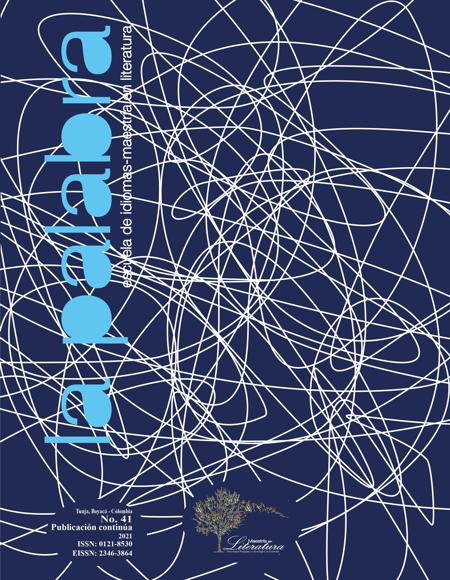The translation in Mexico of Juarez und Maximilian by Franz Werfel

Abstract
This article presents and analyzes the two translations into Spanish of the work published in Mexico Juarez und Maximilian by the Austrian writer Franz Werfel. The analysis is carried out from the cultural semiotics, the communication theory exposed by Göran Sonesson and the negotiation process by Umberto Eco. The complexity of these translations can be found in two aspects: first, it is a work that passed from the German to English and from there to Spanish, but also from German to Spanish; and second, the required knowledge of Mexico’s history to achieve its understanding. As a result, it is possible to distinguish between the discourses of each of the target texts and the base text, as well as their relationship with the biographical features of the translators and their cultural competencies, and the usage of the target texts.
Keywords
Translation, germany, literature, target text, source text
References
- Albaladejo Martínez, Juan Antonio. La literatura marcada: problemas de traducción y recepción ejemplificados a través del teatro popular vienés. Soria, Vertere, Monográficos de la Revista Hermeneus 14, 2012.
- Bastin, Georges. “Por una historia de la traducción en Hispanoamérica”. Íkala. Revista de lenguaje y cultura, vol. 8, núm. 14 ene-dic. (2003): 193-217. Web 29 Oct. 2021. https://www.redalyc.org/pdf/2550/255026028009.pdf
- Cagiao Vila, María del Pilar. “Género y emigración: las mujeres inmigrantes gallegas en la Argentina”. La Galicia Austral. La inmigración gallega en la Argentina. Ed. Xosé Núñez Seixas. Buenos Aires, Editorial Biblos, 2001, pp. 107-138.
- Dusi, Nicola Maria. “Intersemiotic translation: Theories, problems, analysis”. Semiotica. Journal of the International Association for Semiotic Studies, núm. 206 jul. (2015):181-205. Web 14 May. 2021. https://philpapers.org/rec/DUSITT DOI: https://doi.org/10.1515/sem-2015-0018
- Eco, Umberto. Experience in Translation. Trad. Alastair McEwen. Buffalo, University of Toronto Press, 2001.
- Eco, Umberto. Decir casi lo mismo. Experiencias de traducción. Trad. Helena Lozano Miralles. México, Lumen, 2008.
- Gallego Roca, Miguel. “De las vanguardias a la Guerra Civil”. Historia de la traducción en España. Eds. Francisco Lafarga y Luis Pegenaute. Salamanca, Editorial Ambos Mundos, 2004, pp. 479-526.
- Garner, Paul. Porfirio Díaz: entre el mito y la historia. Trad. Luis Pérez. México, Crítica, 2015.
- Islas Flores, Mario César. La escritura imbricada de Robert Musil: Historia política y mística en El hombre sin atributos. Tesis doctoral Universidad Autónoma Metropolitana- Unidad Azcapotzalco, México, 2015.
- Jakobson, Roman. “On linguistic aspects of translation”. On Translation. Ed. Reuben Brower. Cambridge, Harvard University Press, 1959, pp. 232-239. DOI: https://doi.org/10.4159/harvard.9780674731615.c18
- Milhaud, Darius. Maximilien. Opéra historique en trois Actes et neuf Tableaux. Livret de R. S. Hoffmann d’après “Juarez et Maximilien”. Drame de Franz Werfel. Adaptation Française d’Armand Lunel. Viena, Leipzig Universal-Edition, 1931.
- Morales Zea, María del Sol. “Juárez y Maximiliano: cruces entre la literatura y el cine 1924-1933”. Revista Valenciana, núm. 27 ene-jun. (2021): 119-145. Web 29 Oct. 2021. https://doi.org/10.15174/rv.v13i27.51 DOI: https://doi.org/10.15174/rv.v13i27.512
- Musil, Robert. El hombre sin atributos. Trad. José M. Sáenz. Barcelona, Seix Barral, 2004.
- Peñafiel, Antonio. Nomenclatura geográfica de México, vol. 2. México, Oficina Tipográfica de la Secretaría de Fomento, 1897.
- Peredo, Roberto. “Enrique Jiménez Domínguez”. Diccionario enciclopédico veracruzano, Universidad Veracruzana. Web 29 Jun. 2021. https://sapp.uv.mx/egv/about.aspx
- Pérez Martínez, Herón. “Alfonso Reyes y la traducción en México”. Relaciones. Estudios de Historia y Sociedad, vol.14, núm. 56 (1993): 27-74.
- Pyrah, Robert. The Burgtheater and Austrian Identity. Theater and cultural politics in Vienna 1918-1938. Londres, Routledge, 2007.
- Sonesson, Göran. “La traducción como doble acto de comunicación. Entre semiótica cognoscitiva y semiótica de la cultura. Parte I. De la comunicación a la traducción”.
- Interpretatio. Revista de Hermeneútica, vol. 3, núm. 2 (2018-2019): 159-187. Web 29 Oct. 2021. https://revistas-filologicas.unam.mx/interpretatio/index.php/in/article/ view/105
- Vázquez Vela, Gonzalo. Memoria de la Secretaría de Educación Pública, septiembre 1936-agosto 1937, presentada al H. Congreso de la Unión. Tomo 1, segunda parte, México, D.A. P.P., 1937.
- Vega Cernuda, Miguel Ángel. “De la Guerra Civil al pasado inmediato”. Historia de la traducción en España. Eds. Francisco Lafarga y Luis Pegenaute, Salamanca, Editorial Ambos Mundos, 2004, pp. 527-578.
- Werfel, Franz. Juarez und Maximilian. Dramatische historie in 3 phasen und 13 bildern, Berlín, Paul Zsolnay, 1924.
- Werfel, Franz. Juarez and Maximilian. A dramatic history in three phases and thirteen pictures. Trad. Ruth Langner. Nueva York, The Theatre Guild Inc., 1926.
- Werfel, Franz. Juárez y Maximiliano. Historia dramática en tres actos y trece cuadros. Trad. Enrique Jiménez Domínguez. México, Ediciones de “La razón” S. A., 1931.
- Werfel, Franz. Juárez y Maximiliano. Trads. Elvira Martín y Annie Reney. México, Factoría Ediciones, 2002.
- Willson, Patricia. La constelación del Sur. Traductores y traducciones en la literatura argentina del siglo XX. Buenos Aires, Siglo xxi Editores, 2004.
- Yankelevich, Pablo. “México-Argentina. Itinerario de una relación 1910-1930”. Tzintzun. Revista de Estudios Históricos, núm. 45 ene-jun. (2007): 83-104. Web 29 Oct. 2021. https://www.redalyc.org/pdf/898/89804505.pdf
- Zuleta Miranda, María Cecilia. “Alfonso Reyes y las relaciones México-Argentina: proyectos y realidades, 1926-1936”. Historia Mexicana, vol. 45, núm. 4 (1996), pp. 867- 905. Web 29 Oct. 2021. https://www.jstor.org/stable/25139023
